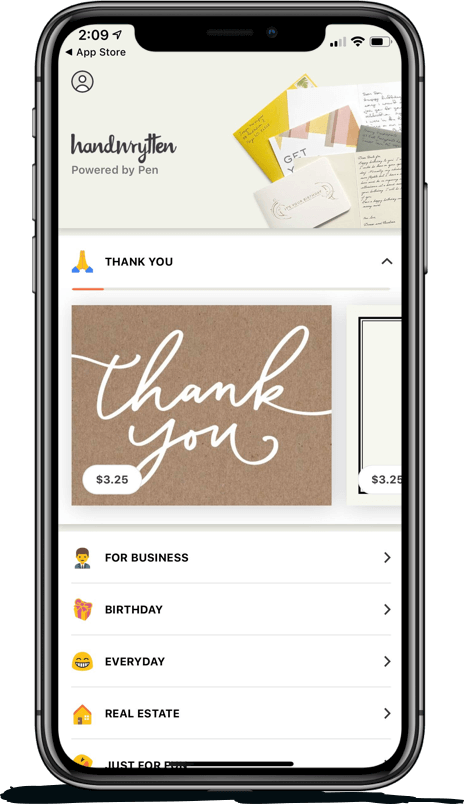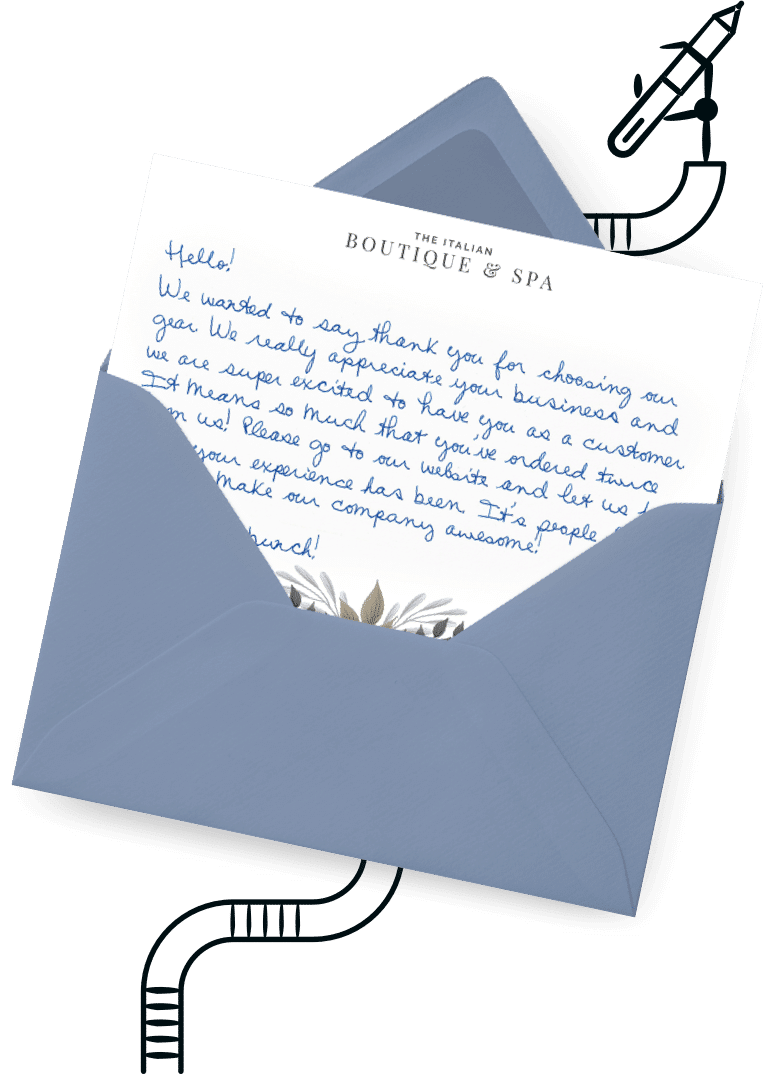
9280 S. Kyrene Rd.
Suite 134
Tempe, AZ 85284
Phone: +1 (888) 284-5197
Email: contact@handwrytten.com



You have been subscribed. Thank you!


Last updated, October 28, 2022
You’re trying to decide which product to purchase. While Product A may be ever so slightly superior to Product B, upon emailing and calling customer support for Product A, you receive no response for a week.
On the other hand, you contact customer support from the creators of Product B; within a day, your email is responded to, with the offer to get on a phone call if you need further explanation. You immediately decide to purchase Product B.
This is an example of exceptional customer service, but more importantly, it is an example of a company that prioritizes customer experience.
Customer experience, sometimes referred to as CX, is how your customer experiences your product or brand. More importantly, CX refers to the customer’s perception of your business.
Every single thing you do in a company – building a strong support team, creating customer retention programs, reaching out for feedback to get customer data – generates and changes a customer’s experience. This is why it is so important to have a great customer experience. Without it, retaining existing customers will almost certainly be difficult.
As we’ve already said, the better the customer experience you can provide, the better the longevity and growth of your brand. By providing the best experience possible, you can rest assured knowing that you will:
The best part about this is that it doesn’t matter what kind of business owner you are.
If you specialize in selling custom coffee mugs, providing a better, more responsive customer experience will lead to repeat customers and repeat purchases, and may even allow you to build relationships with past customers.
On the other hand, for the business owner who has a coffee subscription service, taking into account how customers feel, offering immediate responses to questions, and having good customer service overall, retaining customers will become easier than ever.
Different websites and companies have different ways of establishing a good customer experience. By looking at successful companies, we’ve chosen three core principles for creating a good customer experience.
This is the best way to easily ensure that your customer experience is fantastic. By paying attention to your customer’s interactions and customer complaints, it will be quite simple to understand sticking points that may be disallowing you from keeping customers. The easiest way to collect customer feedback is by using the CSAT.
If you have a near immediate response to customer questions 50% of the time and ignore questions for weeks the other half of the time, your customers will notice. With great customer service comes the responsibility of giving consistently great customer service; this ensures that your brand reputation is maintained, helping to increase client retention and draw in more potential customers.
Have you ever dealt with a customer service representative who gave you quick, concise communication, only to then interact with company representatives who danced around your questions? This is a situation where not all employees are on the same page. Until you make sure that all employees understand that providing good customer experiences is the standard, customer expectations and loyalty will fluctuate, making it more difficult to create loyal customers.
Implementing these three things will take months to do them well, but after they are complete comes the question of what the impact is.
Has your number of customers substantially increased due to better word-of-mouth marketing? Do you have the most loyal customers, providing lifetime value to those who engaged with your business?
The answers can be revealed by measuring customer experience.
At the most basic level, measuring customer experience is easy. There are three commonly used metrics that define a customer’s overall experience: the Net Promoter Score (NPS), Customer Satisfaction (CSAT), and the Customer Effort Score (CES).
The Net Promoter Score, or NPS, is a 1 to 10 scale that rates customer loyalty and level of product approval. This is the most frequently used metric to determine how likely a person is to recommend a product.
The methodology is simple because it consists of one question: “How likely are you to recommend [brand] to a friend?”
The Customer Satisfaction score is a rating of satisfaction; you will frequently see it used with five levels of satisfaction, ranging from ‘Extremely dissatisfied’ to ‘Extremely satisfied’. Businesses can use the CSAT at any moment in the consumer experience, including after purchase or even before it.
Because of this, this is better used as a ‘starter’ metric; the focus of the metric is contingent upon the customer’s feeling in the present moment, leading to a litany of unknown variables playing into how satisfied they may feel.
Lastly, the Customer Effort Score is a measure of the effort that a customer has to make use of to acquire what they are looking for, regardless of whether it is getting their questions answered or ordering a product. Similar to the CSAT, the CES ranges from ‘Strongly disagree’ to ‘Strongly agree’, but it seems that this metric has quite a bit more long-term value than the former two.
Research from Gartner, the research firm that owns the firm that creates the CES, states that 96% of customers become more disloyal with a high-effort service interaction, but only 9% of those who have a low-effort experience show signs of waning loyalty. In plain English, the easier the customer experience and the better the CES score, the fewer unhappy customers there will be. Luckily, there are many ways to measure customer loyalty.
Understanding how to measure customer experiences from the short-term to the long-term is a topic that cannot be covered in the breadth of this article; keep an eye out for a future article from us on how to measure customer experience.
Metrics aside, how can a business offer a good product or service while also focusing on the customer journey? Similarly to measuring customer experience, this is a topic that requires a plethora of detail. For the sake of being succinct, this article will offer the most basic aspects of enhancing the customer journey until we’ve written more about creating a great customer experience. Qualtrics has created a fantastic resource to provide more depth to improving customer experience, in the meantime.
UPDATE: Check out our post discussing ten strategies to improve your customer experience.
To begin, being able to properly communicate with customers during all phases of the customer journey is key. Providing ample information about the product or service upfront, followed by concise instructions as to how to use the service or when the product will arrive will allow the customer to feel like the entire process is fluid.
Beyond that, providing responsive customer service on an as-needed basis, as well as responding to customer reviews online will show that not only do you care about the customer’s issues, but you care about rectifying them. This strengthens your overall brand image and will help to develop connections with your customers. You can perform exercises in customer journey mapping to place yourselves in the customers’ shoes to understand what may provide a better experience for them.
Rewards, such as customer loyalty programs, offer the customer’s an extra incentive to stay loyal to your brand. The majority of customers will see this as a reason to continue purchasing your products; by offering them discounts or sneak peeks of exclusive new product information, they can put more trust in you as a brand, as you have invested back into them.
Customer interactions should always be focused upon the notion of customer-centricity: the idea here is to sell a product or service that continues to pay dividends over time by placing the customer’s needs at the heart of the experience. Offering the customer quick product support and showing that you care about their opinions makes them feel empowered. Based on research that we at Handwrytten conducted, there is significant evidence to show that handwritten cards make the customer feel more appreciated and heard, as well.
None of the above traits of a good consumer experience can be solidly put into place without unified company goals. If only 50% of all customer service technicians prioritize the customer above all else, and none of the upper-level management pay attention to customer feedback, ideas to improve the customer experience will rarely be put into place, leaving long-term customers feeling like their loyalty does not matter. Overall, this will lower customer engagement over time.
Amazon has (not literally) taken the world over when it comes to being a product provider. Some may say that it was just a matter of lots of investing and advertising at the right time. In reality, every part of Amazon’s customer experience makes the customer feel at ease.
From selecting whether to buy a product once or have it automatically reordered every few months, to checking out with saved on file addresses or credit cards, to getting consistent two-day shipping, Amazon makes the entire process of ordering anything easy. With expanded offerings of same-day and two-hour delivery coming into play in recent years, as well, Amazon offers an extreme level of convenience that few companies like it can replicate.
Beyond this, something as simple as writing a customer appreciation letter can help reinforce the reputability of your brand.
Examples of poor customer experience happen around us all the time, ranging from ignored Google Reviews leaving customers’ complaints unanswered to overlooking logic for the sake of company policies. One particular example of bad customer service occurred in a large retailer’s store, where a customer discovered that the product on the shelf was 35% more expensive than the one listed online.
While the customer service desk acknowledged this, they simply said that it was not within company policy to change the price; luckily, the customer ordered the online product for in-store pickup (from the same store) and got it at a lower price.
Regardless, this is an example of not putting the customer lifetime value as a priority; although it was clear to see that, at the very least, the misalignment in pricing should have been remedied, the store simply acknowledged it and did nothing about it.
Customer experience management deals with the technologies, processes, and strategies developed to modify the customer experience. The goal here is to establish a customer-centric brand, one that develops and constantly iterates upon the end-to-end customer experience.
The only difference between customer experience and customer experience management is in who it directly relates to. In customer experience, the current customers are the main stakeholder, whereas, in customer experience management, employees are looking to develop a better customer experience.
Typical companies who want to become more customer-centric use CXM to put automated processes in place to track interactions and other core metrics that provide information to improve the customer’s experience.
As Accenture discusses, the Business of Experience is the future of customer experience. In BX, all individuals within an organization are equal stakeholders in creating exceptional experiences for everybody – customers and employees alike.
Think of this as customer experience evolved to another level, where not only is the customer experience placed at the top of the priority list, but the employee experience is, too. While this may be a future-facing discussion, as many businesses are still struggling to align themselves enough to have a solid customer advocacy strategy, prioritizing both the consumer and the employee will help to remind customers which brands they should align themselves with.
Customer retention occurs when a customer makes repeat purchases over a long period. In other words, customer retention is when a customer is retained; they continue to purchase products from the same business. Many companies, especially subscription-based services, look to the retention of customers as a metric for their success and growth.
Retention of customers helps determine how loyal and happy customers are with their purchases.
If a person makes an initial purchase from an online business and dislikes what they received, or they had a poor customer experience, it is unlikely they will buy that product again. In this case, the customer was not retained.
On the other hand, when a business can build strong relationships with customers, establish a culture that feels akin to a personalized experience, and delivers a fantastic product to boot, new customers will quickly become brand ambassadors. Through word of mouth marketing, these loyal customers will help draw in new customers, helping to further build out your customer base, increasing overall engagement.
The focus on customer retention will pay dividends in the long run.
If we take a step back and put ourselves in the shoes of a customer, what things would affect our decision to make a repeat purchase?
Unsurprisingly, the consumer’s experience may be the strongest catalytic factor when it comes to changing customer retention rates.
Key aspects of the purchasing experience like the ease of ordering, intuitive website design, or quick customer support would make repurchasing easy. A website that loads slowly with nonexistent customer support would lead to us feeling dissatisfied with the associated brand. Based on research from Zendesk, this holds up in the real world.
The 2022 edition of CX Trends discusses a disjointedness in the customer experience process. While nearly four out of five organizations surveyed admit that their customer service needs improvement and 73% acknowledge that there is a direct link between customer experience and business performance, only 54% have a three-year plan to improve it.
This is to say that leadership is aware that an improvement in customer engagement strategy will increase customer retention, never actually develop plans or take progressive steps towards a more holistically rounded focus on customer experience.
Data from the customer side of things confirm that their experience is highly relevant to their future purchasing decisions. 81% of customers say that a positive customer experience significantly increases the likelihood of making another purchase. In terms of this article, 81 out of 100 customers are retained when their customer experience is good. But a strong customer experience goes further than this.
While having repeat customers is beneficial, a loyal customer can only provide so much to a business. True brand ambassadors, those who proudly tell their friends and family about a brand that they hold in high regard, forgive.
74% of customers who have received excellent past experiences will forgive a company, suggesting that brand loyalty is key in customer retention. In most cases, a strong customer retention strategy is simply to place a high priority on creating the best CX possible.
For companies that infrequently listen or respond to customer feedback feel this in the shape of a diminishing customer base. For every year that a company does not ‘close the loop’, there is a 2.1% decrease in customer retention.
While this may seem like a small number, imagine trying to sustain a business for longer than five years while having a customer base that consistently decreases over time; this is nearly impossible.
To internalize how to measure customer retention, let us use an example.
Say that we are measuring customer retention metrics over 60 days. We can start by acquiring key information, like new customers acquired, via various methods such as Google Analytics.
By subtracting the number of new customers gained from the total number of customers at the end of the period, we can see how many customers we retained. In our theoretical case, we had 50 new customers and 300 customers total at the end of the period, so 250 customers were retained.
We can subsequently divide this number by the number of existing customers at the start of the period, say, 400. Multiplying our answer by 100 will give us the customer retention rate, a percentage that reflects how many customers we retained over these 60 days. Here, our CRR is 62.5%.
To begin with, doing some research into average customer retention rates in the industry your business is in can help you see how you stack up to the average organization. Here are some details on the top seven industries in America based on 2020 data.
Media companies specialize in marketing and have an intense focus on targeting clients that will fit in with their culture. While companies in this industry have to focus more on personalizing their product, investing more time and money into doing so, this pays off in increased customer retention rates.
Similar to media companies, companies that offer professional services build relationships and listen to customer feedback, promoting long-term brand loyalty and engagement.
Insurance is an extremely competitive industry, and with hundreds of different agents vying for clients, companies need to establish a competitive advantage over other companies to ensure that their customer acquisition leads to customer loyalty. By offering different benefits like family discounts or yearly bonuses and discounts, insurance companies tend to have solid customer retention rates.
IT companies reside in a very cutthroat industry; it is quite obvious if a company is getting the job done. If they are not completing tasks up to par, or not at the right speed, clients can easily switch to another one. Due to this, IT companies must have an extremely high quality of services and offer a great customer experience, leading to high retention rates.
Various companies in the American telecom industry, similar to insurance companies, offer customer loyalty programs, like discounted family plans, to customers who show loyalty over many years. These programs ensure a high level of retained customers.
Banks have long been established in the states, and they know best of all what it takes to provide a good customer experience. Their long-standing nature acts as a tempting feature that many customers desire: long-term proof of security. This, as well as providing an extremely refined customer experience, leads to good levels of customer retention.
Lastly comes retail. Unsurprisingly, businesses in the retail industry struggle to retain customers, with lower levels of brand loyalty due to there being a focus on the quality of goods, rather than focus on the quality of the brand. However, there is still the potential for customer retention; but it relies on a brand that provides a standout customer experience or customer loyalty program.
There is not a one-size fits all customer retention strategy that will work for every single business, but we do have some strategies to increase customer retention in general. As we just discussed, customer retention rates vary for different industries, suggesting that different adaptations in strategy will affect many businesses in many different ways.
In reality, there are likely hundreds of ways to achieve the outcome of increasing customer retention, including handwritten notes. As long as the idea that customer experience is inextricably linked to customer retention is instilled within your business, it should be quite intuitive to boost customer retention over a long period.
At the simplest level, there are two things to keep in mind.
It has been proven that a smooth onboarding process and a frictionless end leave the customer feeling positive about your brand. Thus, they are more likely to become a repeat customer.
Surprisingly, a solid user onboarding process and a concise end to the customer experience leave most customers more satisfied than a great experience throughout with a rough ending.
This is more of a two-pronged strategy, but gathering information about how customers feel at different stages in their customer experience offers valuable insight into where the process may be lacking.
For example, sending out a survey to measure NPS after a customer has used your product for one month may tell you that they would recommend the product to a friend due to a high degree of satisfaction with the product quality.
But an NPS survey sent out halfway through the ordering process may result in the customer giving a low score due to poor customer experience. Without collecting feedback at multiple touchpoints throughout the process, important feedback can easily be missed, as will opportunities to improve customer retention.
Once this information is gathered, rewarding customers who consistently provide you with feedback or are repeat customers will further entrench their brand loyalty and desire to continue being repeat customers.
Customer experience and retention are complex topics, and ample time should be invested in understanding the intricacies of what was discussed above and what will be discussed in our future articles. The key focal points, simplified for succinctness’ sake, include:
Whether you choose to invest more money into developing a stronger customer service base or invest more time into post-purchase outreach, a handwritten note can add the finishing touch to make your customers feel heard and appreciated. Check out our services to take your customer experience to the next level!
If you’ve made it this far, we appreciate you taking the time to read our article. Our desire to provide a fantastic customer experience while also sharing the knowledge that we have to help other professionals become better has helped us to develop a few tools to help you level up your customer experience.
Dissimilar to email or traditional print marketing, handwritten notes have an 80% open rate. With the vast increased likelihood of opening comes significantly more potential to have an impact on the customer’s purchasing decisions.
Along with these notes, product inserts or gift cards can automatically be included to increase mail open rate and client retention. If you received a gift card or a one-serving coffee pouch with a handwritten card, don’t you think you would pay a bit more attention to that business?
Customer experience teams can even stay in contact and top of past and present buyers minds by sending personalized, pen-written birthday wishes and even ‘happy holidays‘ cards. This will leave a statement that very few marketers can.
Check out our services or other pieces of content like writing a great closing for your card to help lock in more leads.


Scale your handwritten outreach, creating positive impressions and long lasting bond.
Sign Up Today!


Over 100 designs to choose from or design your own. Our online card customizer makes it simple.
Check Out Our Cards!





